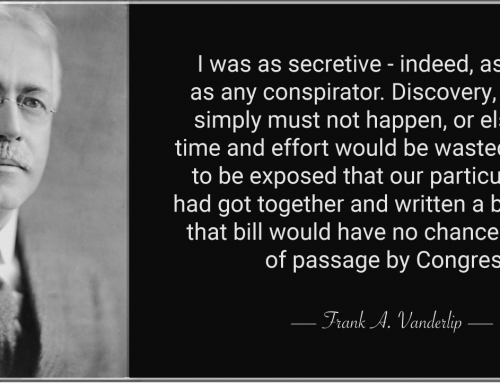Part 4: Secretive as any Conspirator
July 31, 2021
Entering the 1910s, the baron industrialists and their sons had reinvented themselves as financiers. Making money would no longer occur in tandem with production, but would be an end unto itself.1
Due to the Panic of 1907, Wall Street and Washington were looking for a more “permanent solution to financial emergencies.”2 But despite any mutual concerns, the major New York banking houses “wanted such a mechanism to be established on their terms.”3
In typical fashion, Congress responded to the public outrage directed at the bankers by setting up a “bipartisan National Monetary Commission to develop a banking reform proposal and study the problems underlying the panic.”4 The commission was headed by bank apologist Senator Nelson Aldrich of Rhode Island.
In 1910, Senator Aldrich went to Europe to observe European banks. He was accompanied by James Stillman, president of National City Bank, who had banking alliances with both J.P. Morgan and the Rockefellers.
Personal ties among the financial elites were important and extensive, and marriage seemed to be a common means of consolidating business relationships. For example, William Rockefeller (John D. Rockefeller’s brother) worked with James Stillman’s National City Bank to develop the family’s banking interests. Stillman’s daughter married William Rockefeller’s son who years later became National City Bank’s chairman. Closely associated with the Rockefellers was the investment firm of Kuhn, Loeb and Company. Jacob Schiff, head of Kuhn, Loeb had married Solomon Loeb’s daughter, Therese. (Schiff was the primary funder of Woodrow Wilson’s campaign for president in 1912.) Schiff’s daughter, Frieda, married Felix Warburg, a member of the Warburg banking family of Hamburg, Germany who became a senior partner in Kuhn, Loeb. To keep it all in the family, Felix’s brother, Paul Warburg, also a banker, immigrated from Germany and married Solomon Loeb’s youngest daughter, Nina. Paul Warburg would later become a lead developer of the Federal Reserve System.5
But the most notable consolidation of mutual interests, the social event of the year in 1901, was the marriage of the son of John D. Rockefeller to the daughter of Senator Nelson Aldrich.6 As the young couple pronounced their marriage vows as a covenant before God, their fathers were celebrating an alliance of money and political power that foreshadowed the creation of the Federal Reserve System.
By 1910, Senator Aldrich was determined to create an American banking system that would “promote America’s power and stature in the world, and would support bankers with an excess money source in their quest for domestic and international financial control.”7
“Retaining secrecy was crucial for Aldrich and the bankers…. If the notion of private bankers influencing a central bank was unpalatable to the public, the idea of private bankers constructing America’s path to achieve global power would be impossible to get approved.”8
Frank Vanderlip, vice president of National City (the primary Rockefeller bank) and an active participant in the creation of the Fed, noted, “there was an occasion near the close of 1910, when I was as secretive… as any conspirator.”9
To avoid publicity, “the Federal Reserve plan would be penned clandestinely”10 on a remote private resort off the coast of Georgia called Jekyll Island.
Coming – Part 5: The Journey to Jekyll Island
___________________________________________________





